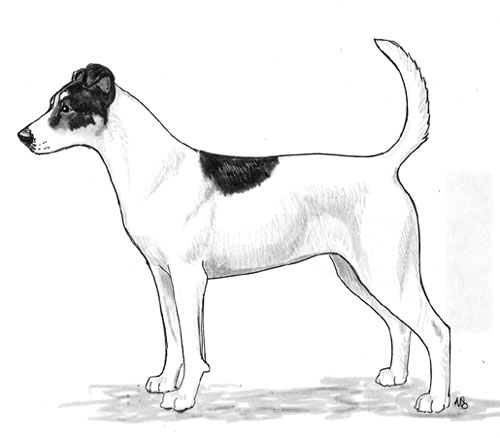Danish Swedish Farmdog
Terrier Group
The goals and purposes of this breed standard include: to furnish guidelines for breeders who wish to maintain the quality of their breed and to improve it; to advance this breed to a state of similarity throughout the world; and to act as a guide for judges.
Breeders and judges have the responsibility to avoid any conditions or exaggerations that are detrimental to the health, welfare, essence and soundness of this breed, and must take the responsibility to see that these are not perpetuated.
Any departure from the following should be considered a fault, and the seriousness with which the fault should be regarded should be in exact proportion to its degree and its effect upon the health and welfare of the dog and on the dog’s ability to perform its traditional work.
History
Though this breed was not recognized under its current name until 1987, the breed has been known for centuries on farms in Denmark and Sweden. It has been used as a watchdog, ratter and companion. The Farmdog is more closely related to the Pinschers than it is to the Terriers. The breed’s FCI classification is Pinscher and Schnauzer, Molossoid breeds-Swiss Mountain and Cattle Dogs.
The Danish-Swedish Farmdog was recognized by the United Kennel Club in 2008.
General Appearance
A small, compact, smooth coated breed that is slightly rectangular in shape, the Danish-Swedish Farmdog is a breed known to mature quite late.
Characteristics
Alert, intelligent, attentive and lively.
Head
The head is triangular in shape and slightly small in proportion to the size of the body.
SKULL
The skull is fairly broad between the ears. It is only slightly rounded. The cheeks are well filled and slightly pronounced, without exaggeration. The stop is well marked.
MUZZLE
The muzzle is well developed and slightly shorter than the skull. It narrows gradually from the eyes to the nose but must never give a snipy appearance. The nasal bone is straight.
TEETH
The Danish-Swedish Farmdog has a powerful jaw with well developed incisors and a scissors or level bite.
NOSE
The color of the nose is in accordance with the color of the coat patches.
EYES
The eyes are medium in size and slightly rounded in shape, being neither protruding nor sunken. The color should be as dark as possible, though in dogs that have yellow or liver patches a somewhat lighter eye is acceptable. The expression is attentive and kind.
EARS
The ears are medium in size, either rose or button, and very mobile. In both, the fold should be just above the line of the skull.
In button ears the tip should lie close to the cheek.
Fault: Prick ears.
Neck
The neck is clean, strong, slightly arched and medium in length.
Fault: Neck too long.
Forequarters
The forequarters are broad and well-developed. They are proportionally broader than the ribcage. The shoulder blades and upper arms are obliquely placed and form a good angle.
FORELEGS
The legs are straight and parallel to one another. They are set rather wide apart due to the development of the chest. The length of the legs from elbow to ground is one-half the height at the withers. The pasterns are strong and springy.
Faults: Narrow in front. Low on legs.
Body
The body is compact, with good substance. In proportion, it is slightly longer than tall in a ratio of 10:9. The chest is long, deep and roomy. The ribs are very well sprung. The forechest is well-defined. The loin is short, broad and slightly arched, and the croup is slightly rounded. Belly is only slightly tucked up.
Faults: Elegant general appearance. Lack of depth of body. Flat or short ribcage. Steep croup.
Hindquarters
The hindquarters are parallel and well muscled.
HIND LEGS
The upper thighs are broad. There is good angulation at the stifle and hock joints.
Feet
The feet are small and oval. The toes are not tightly knit.
Tail
The tail is not set too high. The tail may be naturally long or naturally bobbed. It should be carried straight, with a slight curve or in a sickle shape.
Faults: Curled tail, or tail carried flat on the back.
Coat
The coat is short, smooth and harsh on the body.
Color
White is the predominating color. There are broken patches of different colors such as black, tan, brown and shades of fawn that are allowable in different sizes and combinations. There may be tan points. Ticking or flecking is acceptable.
Height
Height at the withers for males is 13.25-14.5 inches. (34-37cm). For females, it is 12.5 to 14 inches. (32-35cm). There is a tolerance of .75 inches in either direction (+/- 2cm).
Gait
Parallel and free.
Disqualifications
(A dog with a Disqualification must not be considered for placement in a conformation event, and must be reported to UKC.)
Unilateral or bilateral cryptorchid.
Viciousness or extreme shyness.
Albinism.

Looking for a Dog?
Find a dog that will fit your family.
Note: The breeders on this list are not endorsed by UKC.
©Copyright 2008, United Kennel Club
